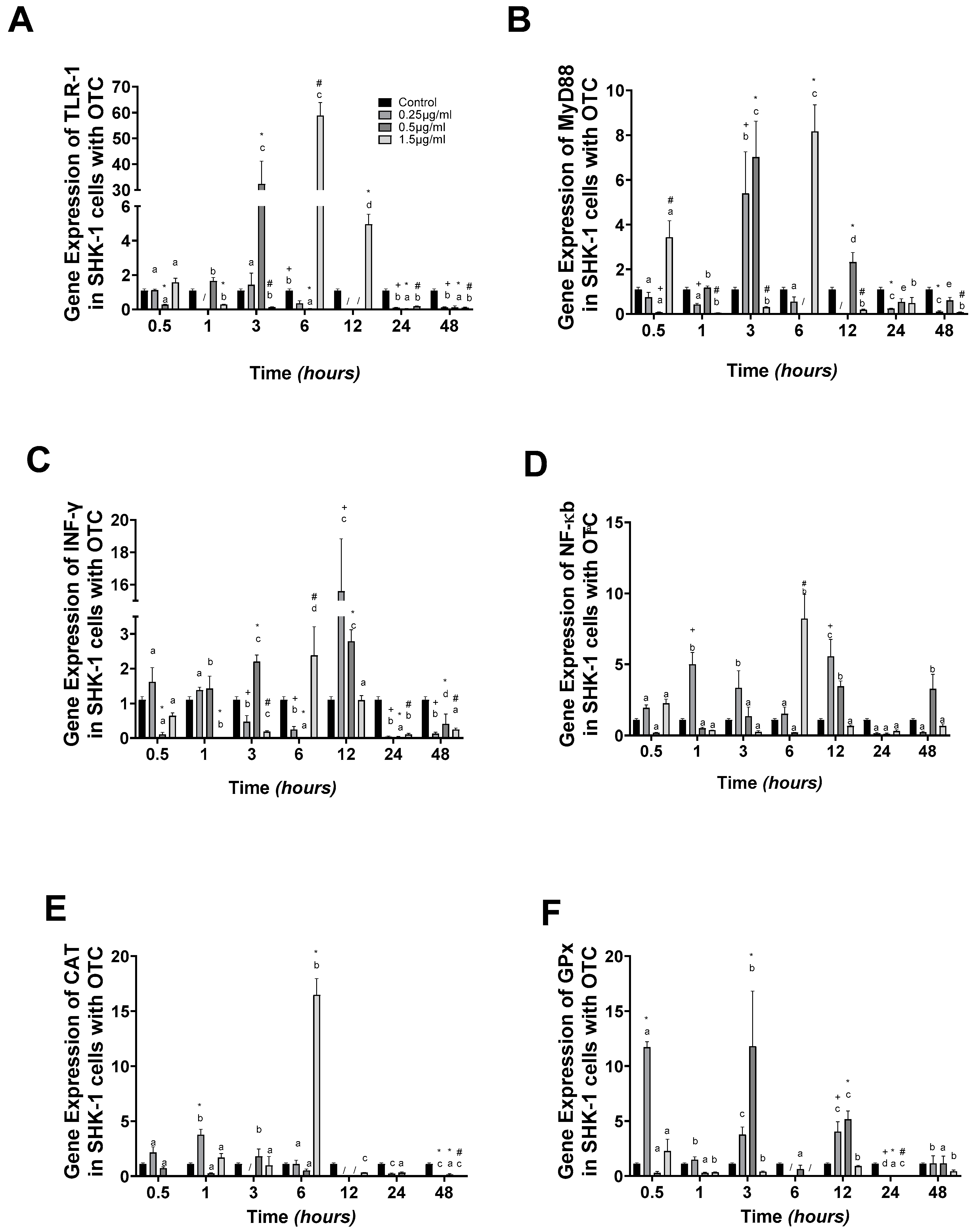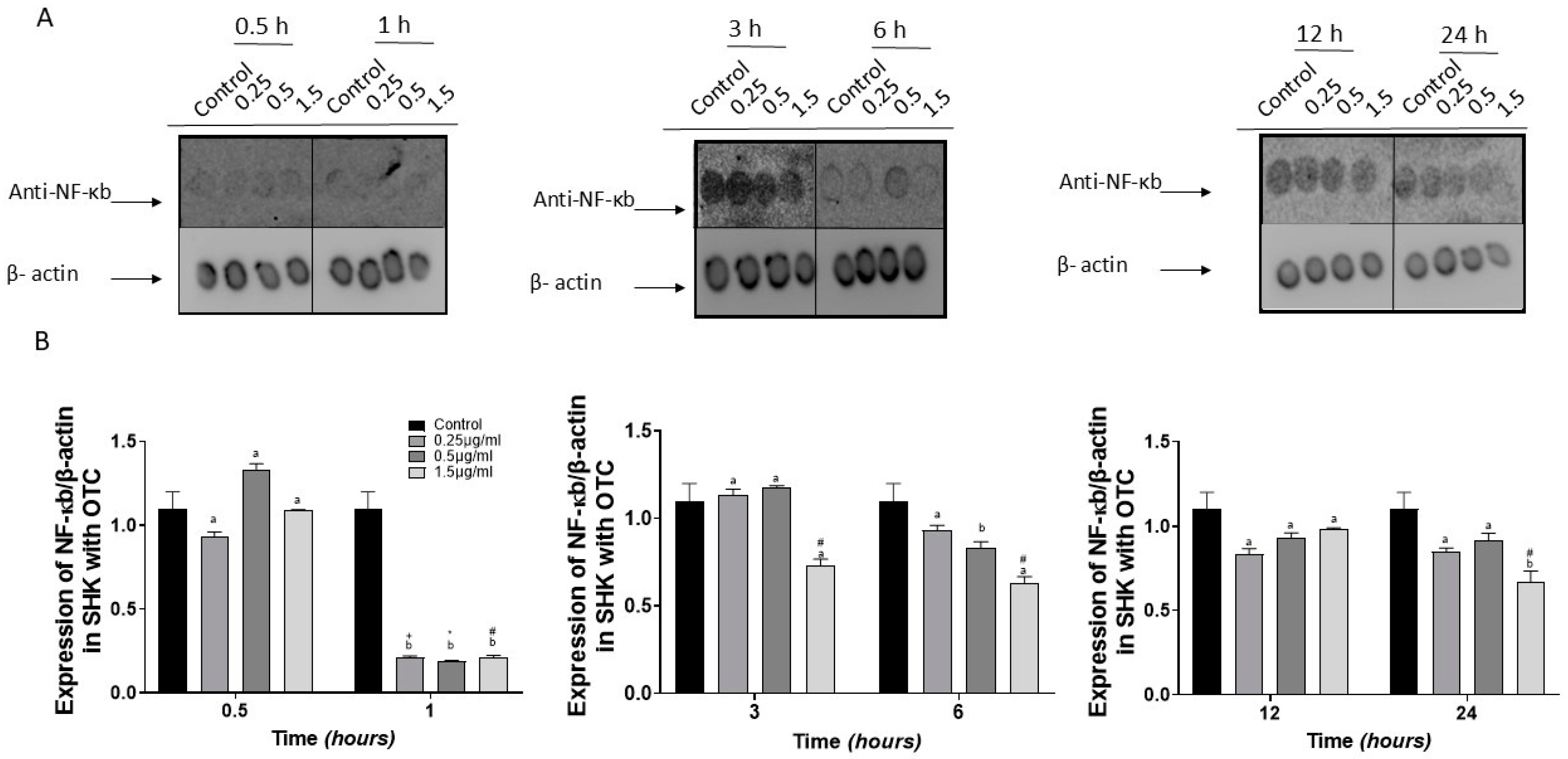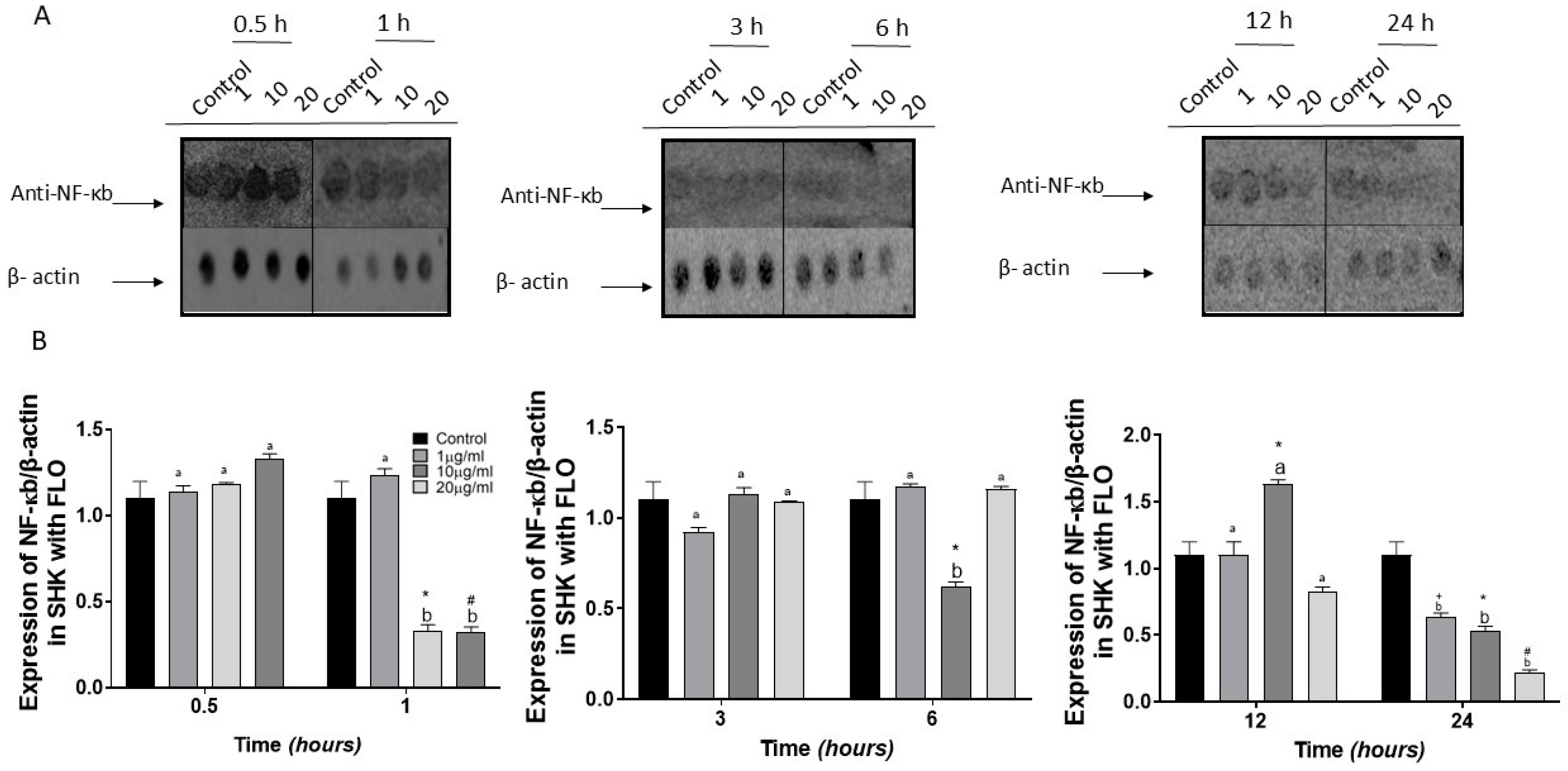The Oxytetracycline and Florfenicol Effect on the Immune System and Oxidative Stress Response of the SHK-1 Cell Line of Salmo salar
Abstract
1. Introduction
2. Materials and Methods
2.1. Gene Expression Analyses
2.2. Immunodetection of NFκb in SHK-1 Cells (Dot Blot for NFκb)
2.3. Statistical Analyses
3. Results
3.1. Oxytetracycline (OTC)
3.2. Florfenicol (FLO)
4. Discussion
5. Conclusions
Author Contributions
Funding
Institutional Review Board Statement
Data Availability Statement
Acknowledgments
Conflicts of Interest
References
- FAO. The State of World Fisheries and Aquaculture 2022; Food and Agriculture Organization of the United Nations: Rome, Italy, 2022; p. 288.
- Vargas-Chacoff, L.; Regish, A.M.; Weinstock, A.; McCormick, S.D. Effects of elevated temperature on osmoregulation and stress responses in Atlantic salmon Salmo salar smolts in fresh water and seawater. J. Fish Biol. 2018, 93, 550–559. [Google Scholar] [CrossRef] [PubMed]
- Vargas-Lagos, C.; Pontigo, J.P.; Oyarzún, R.; Soto-Dávila, M.; Morera, F.; Yáñez, A.; Vargas-Chacoff, L. Intestinal incomplete process on the osmoregulation system during Salmo salar smoltification in a productive conditions. Aquaculture 2018, 491, 121–127. [Google Scholar] [CrossRef]
- SERNAPESCA. Report with Health Background of Freshwater and Sea Year 1st Semester 2023; Department of Animal Health Sub-Directorate of Aquaculture National Fisheries and Aquaculture Service: Valparaiso, Chile, 2023; p. 55.
- Bravo, S.; Dolz, H.; Silva, M.T.; Lagos, C.; Millanao, A.; Urbina, M. Informe Final. Diagnostico del uso de Fármacos y Otros Productos Químicos en la Acuicultura; Casilla 1327; Proyecto No. 2003-28; Instituto de Acuicultura, Facultad de Pesquerias y Oceanografia, Universidad Austral de Chile: Puerto Montt, Chile, 2005. [Google Scholar]
- Sapkota, A.R.; Kucharski, M.; Burke, J.; McKenzie, S.; Walker, P.; Lawrence, R. Aquaculture practices and potential human health risks: Current knowledge and future priorities. Environ. Int. 2008, 34, 1215–1226. [Google Scholar] [CrossRef]
- Rodgers, C.; Furones, M. Antimicrobial agents in aquaculture: Practice, needs and issues. In The Use of Veterinary Drugs and Vaccines in Mediterranean Aquaculture; Rogers, C., Basurco, B., Eds.; Zaragoza-CIHEAM: Zaragoza, España, 2009; p. 41e59. [Google Scholar]
- Cabello, F.C. Antibiotics and Aquaculture. An Analysis of Their Potential Impact Upon the Environment, Human and Animal Health in Chile. Fundacion Terram. Analisis de Politicas Publicas No. 17. 2003. pp. 1–16. Available online: http://www.terram.cl/docs/App17_Antibioticos_y_Acuicultura.pdf (accessed on 24 November 2024).
- Cabello, F.C. Antibiotics and aquaculture in Chile: Implications for human and animal health. Rev. Med. Chil. 2004, 132, 1001–1006. [Google Scholar]
- Brodersen, D.E.; Clemons, W.M.; Carter, A.P.; Morgan-Warren, R.J.; Wimberly, B.T.; Ramakrishnan, V. The structural basis for the action of the antibiotics tetracycline, pactamycin, and hygromycin B, on the 30S ribosomal subunit. Cell 2000, 103, 1143–1154. [Google Scholar] [CrossRef]
- Pioletti, M. Crystal structures of complexes of the small ribosomal subunit with tetracycline, edeine and IF3. EMBO J. 2001, 20, 1829–1839. [Google Scholar] [CrossRef]
- Christensen, A.M.; Ingerslev, F.; Baun, A. Ecotoxicity of mixtures of antibiotics used in aquacultures. Environ. Toxicol. Chem. 2006, 25, 2208–2215. [Google Scholar] [CrossRef] [PubMed]
- Avendaño-Herrera, R.; Mancilla, M.; Miranda, C.D. Use of antimicrobials in Chilean Salmon farming: Facts, myths and perspectives. Rev. Aquac. 2023, 15, 89–111. [Google Scholar] [CrossRef]
- Elema, M.O.; Hoff, K.A.; Kristensen, H.G. Bioavailability of oxytetracycline from medicated feed administered to Atlantic salmon (Salmo salar L.) in seawater. Aquaculture 1996, 143, 7–14. [Google Scholar] [CrossRef]
- Munita, J.M.; Arias, C.A. Mechanisms of Antibiotic Resistance. Microbiol. Spectr. 2016, 4, 464–473. [Google Scholar] [CrossRef]
- Troncoso, C.; Pavez, M.; Santos, A.; Salazar, R.; Barrientos, L. Structural and Physiological Implications of Bacterial Cell in Antibiotic Resistance Mechanisms. Int. J. Morphol. 2017, 35, 4. [Google Scholar]
- Nakano, T.; Hayashi, S.; Nagamine, N. Effect of excessive doses of oxytetracycline on stress-related biomarker expression in coho salmon. Environ. Sci. Pollut. Res. 2018, 25, 7121–7128. [Google Scholar] [CrossRef]
- Rodrigues, S.; Antunes, S.C.; Correia, A.T.; Nunes, B. Rainbow trout (Oncorhynchus mykiss) pro-oxidant and genotoxic responses following acute and chronic exposure to the antibiotic oxytetracycline. Ecotoxicology 2017, 26, 104–117. [Google Scholar] [CrossRef]
- Vadillo, E.; Pelayo, R. Toll-like receptors in development and function of the hematopoietic system. Rev. Investig. Clin. 2012, 64, 461–476. [Google Scholar]
- Rauta, P.R.; Samanta, M.; Dash, H.R.; Nayak, B.; Das, S. Toll-like receptors (TLRs) in aquatic animals: Signaling pathways, expressions and immune responses. Immunol. Lett. 2014, 158, 14–24. [Google Scholar] [CrossRef]
- Ochoa, D.M.; González, J.F. Estrés oxidativo en peces inducido por contaminantes ambientales. Rev. Med. Vet. Zoot. 2008, 55, 115–126. [Google Scholar]
- Lopez-Galindo, C.; Vargas-Chacoff, L.; Nebot, E.; Casanueva, J.F.; Rubio, D.; Sole, M.; Mancera, J.M. Sublethal effects of the organic antifoulant Mexel (R) 432 on osmoregulation and xenobiotic detoxification in the flatfish Solea senegalensis. Chemosphere 2010, 79, 78–85. [Google Scholar] [CrossRef]
- Lopez-Galindo, C.; Vargas-Chacoff, L.; Nebot, E.; Casanueva, J.F.; Rubio, D.; Sole, M.; Mancera, J.M. Biomarker responses in Solea senegalensis exposed to sodium hypochlorite used as antifouling. Chemosphere 2010, 78, 885–893. [Google Scholar] [CrossRef]
- Pontigo, J.P.; Vargas-Chacoff, L. Growth hormone (GH) and growth hormone release factor (GRF) modulate the immune response in the SHK-1 cell line and leukocyte cultures of head kidney in Atlantic salmon. Gen. Comp. Endocrinol. 2021, 300, 113631. [Google Scholar] [CrossRef]
- Nualart, D.P.; Dann, F.; Oyarzún-Salazar, R.; Morera, F.J.; Vargas-Chacoff, L. Immune Transcriptional Response in Head Kidney Primary Cell Cultures Isolated from the Three Most Important Species in Chilean Salmonids Aquaculture. Biology 2023, 12, 924. [Google Scholar] [CrossRef]
- Tafalla, C.; Novoa, B.; Alvarez, J.M.; Figueras, A. In vivo and in vitro effect of oxytetracycline treatment on the immune response of turbot, Scophthalmus maximus (L.). J. Fish Dis. 1999, 22, 271–276. [Google Scholar] [CrossRef]
- Martinsen, B.; Horsberg, T.E.; Varma, K.J.; Sams, R. Single dose pharmacokinetic study of florfenicol in Atlantic salmon (Salmo salar) in sea water at 118C. Aquaculture 1993, 112, 1–11. [Google Scholar] [CrossRef]
- Livak, K.J.; Schmittgen, T.D. Analysis of relative gene expression data using realtime quantitative PCR and the 2−ΔΔct method. Methods 2001, 25, 402–408. [Google Scholar] [CrossRef]
- Martínez, D.; Vargas-Lagos, C.; Oyarzún, R.; Loncoman, C.A.; Pontigo, J.P.; Yáñez, A.J.; Vargas-Chacoff, L. Temperature modulates the immunological response of the sub-antarctic notothenioid fish Eleginops maclovinus injected with Piscirickettsia salmonis. Fish Shellfish Immunol. 2018, 82, 492–503. [Google Scholar] [CrossRef]
- Pedro, A.V.F.; Martínez, D.; Pontigo, J.P.; Vargas-Lagos, C.; Hawes, C.; Wadsworth, S.; Morera, F.J.; Vargas-Chacoff, L.; Yáñez, A.J. Transcriptional activation of genes involved in oxidative stress in Salmo salar challenged with Piscirickettsia salmonis. Comp. Biochem. Physiol. B 2019, 229, 18–25. [Google Scholar] [CrossRef]
- Kopp, E.B.; Medzhitov, R. The toll-receptor family and control of innate immunity. Curr. Opin. Immunol. 1999, 11, 13–18. [Google Scholar] [CrossRef] [PubMed]
- Gay, N.J.; Keith, F.J. Drosophila toll and IL-1 receptor. Nature 1991, 351, 355–356. [Google Scholar] [CrossRef]
- Duan, T.; Du, Y.; Xing, C.; Wang, H.Y.; Wang, R.-F. Toll-Like Receptor Signaling and Its Role in Cell-Mediated Immunity. Front. Immunol. 2022, 13, 812774. [Google Scholar] [CrossRef]
- Boltana, S.; Aguilar, A.; Sanhueza, N.; Donoso, A.; Mercado, L.; Imarai, M.; Mackenzie, S. Behavioral fever drives epigenetic modulation of the immune response in fish. Front. Immunol. 2018, 9, 1241. [Google Scholar] [CrossRef]
- Gallo, A.; Landi, R.; Rubino, V.; Di Cerbo, A.; Giovazzino, A.; Palatucci, A.T.; Centenaro, S.; Guidetti, G.; Canello, S.; Cortese, L.; et al. Oxytetracycline induces DNA damage and epigenetic changes: A possible risk for human and animal health? PeerJ 2017, 5, e3236. [Google Scholar] [CrossRef]
- Manríquez, R.A.; Sandoval, M.; Loncoman, C.; Tafalla, C.; Avendaño-Herrera, R.; Cárcamo, J.G. Epigenetic reprogramming around IFN1 and IFNy2 promoters in rainbow trout cells inoculated with infectious pancreatic necrosis virus (IPNV). Fish Shellfish Immunol. 2023, 140, 108947. [Google Scholar] [CrossRef] [PubMed]
- Rijkers, G.T.; Teunissen, A.G.; Van Oosterom, R.; Van Muiswinkel, W.B. The immune system of cyprinid fish: The immunosuppressive effect of the antibiotic oxytetracycline in carp (Cyprinus carpio L.). Aquaculture 1980, 19, 177–189. [Google Scholar] [CrossRef]
- Guardiola, F.A.; Cerezuela, R.; Meseguer, J.; Esteban, M.A. Modulation of the immune parameters and expression of genes of gilthead seabream (Sparus aurata L.) by dietary administration of oxytetracycline. Aquaculture 2012, 334–337, 51–57. [Google Scholar] [CrossRef]
- Lundén, T.; Miettinen, S.; Lönnström, L.-G.; Lilius, E.-M.; Bylund, G. Effect of florfenicol on the immune response of rainbow trout (Oncorhynchus mykiss). Vet. Immunol. Immunopathol. 1999, 67, 317–325. [Google Scholar] [CrossRef]
- Morris, G.; Gevezova, M.; Sarafian, V.; Maes, M. Redox regulation of the immune response. Cell. Mol. Immunol. 2022, 19, 1079–1101. [Google Scholar] [CrossRef]
- Wang, X.; Han, C.; Cui, Y.; Geng, Y.; Wei, Y.; Shi, W.; Bao, Y. Florfenicol induces renal toxicity in chicks by promoting oxidative stress and apoptosis. Environ. Sci. Pollut. R. 2021, 28, 936–946. [Google Scholar] [CrossRef]
- Zaki, M.M.; Eissa, A.E.; Saeid, S. Assessment of the immune status in Nile Tilapia (Oreochromis niloticus) experimentally challenged with toxogenic/septicemic bacteria during treatment trial with florfenicol and enrofloxacin. World. J. Fish. Mar. Sci. 2011, 3, 21–36. [Google Scholar]
- Oliveira, R.; McDonough, S.; Ladewig, J.C.L.; Soares, A.M.V.M.; Nogueira, A.J.A.; Domingues, I. Effects of oxytetracycline and amoxicillin on development and biomarkers activities of zebrafish (Danio rerio). Environ. Toxicol. Pharmacol. 2013, 36, 903–912. [Google Scholar] [CrossRef]
- Caipang, C.M.A.; Lazado, C.C.; Brinchmann, M.F.; Berg, I.; Kiron, V. In vivo modulation of immune response and antioxidant defense in Atlantic cod, Gadus morhua following oral administration of oxolinic acid and florfenicol. Comp. Biochem. Physiol. Part C 2009, 150, 459–464. [Google Scholar] [CrossRef]
- Björklund, H.; Bylund, G. Temperature-related absorption and excretion of oxytetracycline in rainbow trout (Salmo gairdneri R.). Aquaculture 1990, 84, 363–372. [Google Scholar] [CrossRef]
- Yonar, M.E.; Yonar, S.M.; Silici, S. Protective effect of propolis against oxidative stress and immunosupression induced by oxytetracycline in rainbow trout (Oncorhynchus mykiss, W.). Fish Shellfish Immunol. 2011, 31, 318–325. [Google Scholar] [CrossRef] [PubMed]
- Yonar, M.E. The effect of lycopene on oxytetracycline-induced oxidative stress and immunosuppression in rainbow trout (Oncorhynchus mykiss, W.). Fish Shellfish Immunol. 2012, 32, 994–1001. [Google Scholar] [CrossRef] [PubMed]
- Pêsa, T.S.; Saccol, E.M.H.; Londero, E.P.; Bressan, C.A.; Ourique, G.M.; Rizzetti, T.M.; Prestes, O.D.; Zanella, R.; Baldisserotto, B.; Pavanato, M.A. Protective effect of quercetin against oxidative stress induced by oxytetracycline in muscle of silver catfish. Aquaculture 2018, 484, 120–125. [Google Scholar] [CrossRef]




| Primer | Nucleotide Sequences (5′→3′) | Efficiency (%) | GenBank No/Reference |
|---|---|---|---|
| TLR-1 Fw | TCCGGAGACGTTTCATCCCA | 102.91 | MF945984 |
| TLR-1 Rv | GAGGTTCAGCGCTAACAGCA | ||
| MyD 88 Fw | CTTTCACAACCACCGAAGCC | 101.6 | Martinez et al., 2018 [29] |
| MyD 88 Rv | TACAAACCGAAACCGCTCCT | ||
| INF-γ Fw | GCCGTGTGTTGGTTTTTGATTT | 100.1 | Martinez et al., 2018 [29] |
| INF-γ Rv | GTGTCTGTCTGACTGATGGTGA | ||
| NFκ-b Fw | AAAGTGCCAGTACCAAGCCC | 102.5 | Martinez et al., 2018 [29] |
| NFκ-b Rv | CATGCTGATGAGCTACTGTTGTT | ||
| CAT Fw | CTGCCAGCAACCCAGATTAT | 101.9 | NM_001140302.1 |
| CAT Rv | ACCAAACCTTGGTGAGATCG | ||
| GPx Fw | GAACTGCAGCAATGGTGAGA | 102.7 | Pedro et al., 2019 [30] |
| GPx Rv | CATGAGAGAGATGGGGTCGT | ||
| 18S Fw | GTCCGGGAAACCAAAGTC | 102.1 | Pedro et al., 2019 [30] |
| 18S Fw | TTGAGTCAAATTAAGCCGCA |
Disclaimer/Publisher’s Note: The statements, opinions and data contained in all publications are solely those of the individual author(s) and contributor(s) and not of MDPI and/or the editor(s). MDPI and/or the editor(s) disclaim responsibility for any injury to people or property resulting from any ideas, methods, instructions or products referred to in the content. |
© 2024 by the authors. Licensee MDPI, Basel, Switzerland. This article is an open access article distributed under the terms and conditions of the Creative Commons Attribution (CC BY) license (https://creativecommons.org/licenses/by/4.0/).
Share and Cite
Vargas-Chacoff, L.; Figueroa, D.; Nualart, D.; Muñoz, J.L. The Oxytetracycline and Florfenicol Effect on the Immune System and Oxidative Stress Response of the SHK-1 Cell Line of Salmo salar. Fishes 2024, 9, 493. https://doi.org/10.3390/fishes9120493
Vargas-Chacoff L, Figueroa D, Nualart D, Muñoz JL. The Oxytetracycline and Florfenicol Effect on the Immune System and Oxidative Stress Response of the SHK-1 Cell Line of Salmo salar. Fishes. 2024; 9(12):493. https://doi.org/10.3390/fishes9120493
Chicago/Turabian StyleVargas-Chacoff, Luis, Daniela Figueroa, Daniela Nualart, and José Luis Muñoz. 2024. "The Oxytetracycline and Florfenicol Effect on the Immune System and Oxidative Stress Response of the SHK-1 Cell Line of Salmo salar" Fishes 9, no. 12: 493. https://doi.org/10.3390/fishes9120493
APA StyleVargas-Chacoff, L., Figueroa, D., Nualart, D., & Muñoz, J. L. (2024). The Oxytetracycline and Florfenicol Effect on the Immune System and Oxidative Stress Response of the SHK-1 Cell Line of Salmo salar. Fishes, 9(12), 493. https://doi.org/10.3390/fishes9120493






